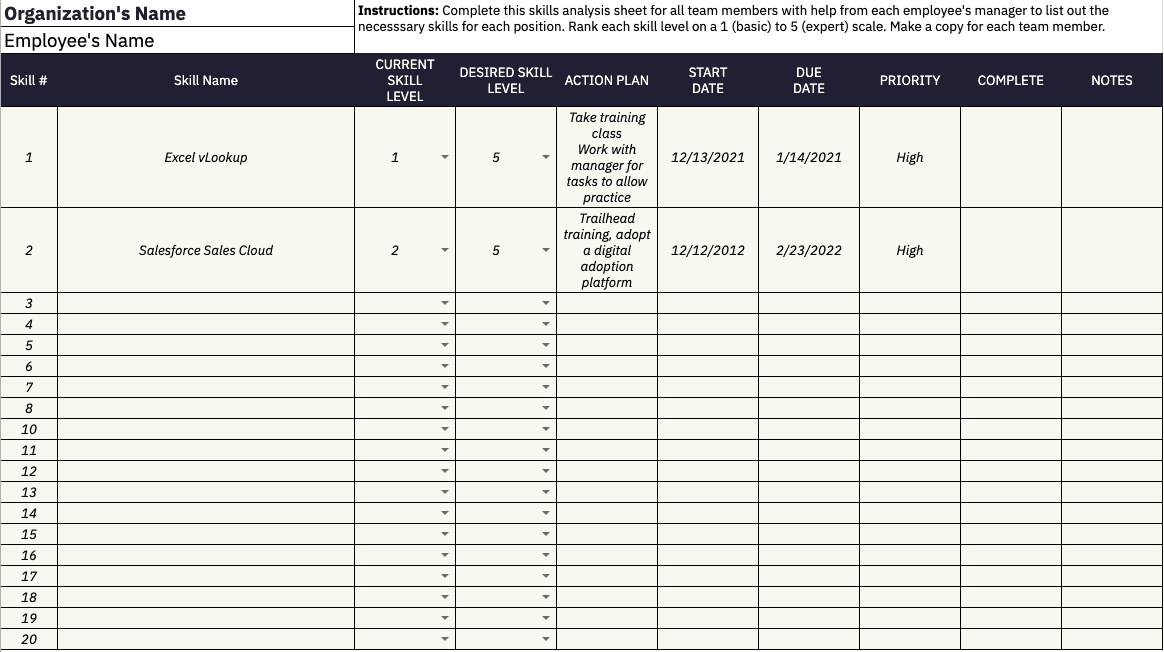

Levi Olmstead

Cultivating a continuous learning and development culture is key to ensuring organizations remain resilient in the face of changing market pressures and technological advancements. A learning culture fosters a mentality where curiosity thrives, and knowledge is shared and applied.
An organizational learning culture is more than providing employee training programs or encouraging employees to take professional development courses. It’s about creating an environment where learning is an integral part of the day-to-day experience, where employees feel empowered to explore new ideas, expand their skill sets, and contribute to a learning organization.
In this article, we will explore how to build a culture of learning and strategies that can be employed to encourage continuous learning.
Whether you are an executive, a manager, or an HR professional, you’ll find valuable L&D insights and practical advice in this piece to help you create an environment where learning becomes an essential part of your company’s DNA.
A workplace learning culture is an atmosphere that prioritizes and emphasizes ongoing learning and development for individual employees and the organization.
Fostering a workplace learning culture means acquiring and sharing new knowledge and skills is actively encouraged. When employees are prompted and encouraged to learn more, they become better employees – more motivated and engaged in their work, more enthusiastic in their team projects and collaborations, and more able to meet the growing needs of an expanding business in an ever-changing field.
Learning organizations foster new skill development that can improve employee retention rates. Rather than replacing an employee to fill a skills gap, employers can upskill their existing workforce, training them in new areas that will allow them to keep up with changing technical demands.
Organizations that invest in their employee development tend to have better employee engagement, more satisfied workers, higher levels of retention, and cultivate future leaders.
Here are six characteristics of companies with a learning culture:
Investing in a culture of organizational learning has a downstream effect that impacts all areas of your business. Here are a few of the most impactful benefits of building a learning culture:
Establishing a culture of organizational learning is often met with resistance and faces barriers to implement. Here are a few critical challenges that keep organizations from building a continuous learning culture:
Most organizations claim to value continuous learning, but few can put words into action. The best examples of thriving learning cultures are in Silicon Valley, which has been the secret ingredient that our generation’s most powerful tech companies have used to establish themselves as industry giants.
Google has perhaps the most well-known learning culture, which has sparked an L&D revolution before investing in upskill training was trendy.
Google has a four-pillar philosophy regarding learning; learning is a process, learning happens in real life, learning is personal, and learning is social.
These learning principles have guided Google to design, arguably, the most effective learning organization in history. Here are a few examples of innovative L&D initiatives that have driven to Google’s success and built their learning culture:
While implementing a thriving learning culture in your organization’s workplace may take time, effort, and attention to detail, the lasting benefits will be well worth it. Here are practical tips and best practices to help you build a strong learning culture in your organization.
Anyone can become an agile learner. All you need is a sense of curiosity, a desire to seek out new experiences, a willingness to learn from mistakes, and an openness to new perspectives that may challenge your previously held assumptions.
For organizations seeking to gain a competitive edge and continue to grow in a saturated marketplace, seeking out agile learners as new hires is a smart choice. When new employees are naturally inclined to continue learning and improving their skills and abilities, they will become valuable employees ready to engage in learning within the organization.
As you develop your company’s learning culture, your organization will naturally attract more employees dedicated to lifelong learning and who want to support others as they learn.
When it comes to employees who already work at the organization, encourage a spirit of openness, curiosity, and fun. If you can draw out the intrinsic desire to learn within current employees, you will have a dynamic, resilient, and engaged workforce. Look for opportunities to provide challenges for employees and offer extra learning support in the form of coaches, mentors, and training geared towards stimulating learning and growth.
Investing in employee training software and new L&D tools is a great way to encourage self-motivated on-the-job training. It enables employees to shape their learning journeys, giving them a sense of autonomy and empowerment. These are vital characteristics that can boost overall morale within the workplace and give employees added motivation to pursue their studies.
Learning L&D technology can also help employees to review or hone their preexisting skills or to upskill and develop new abilities.
Studies have shown that business leaders are very concerned about how inflation is impacting their businesses and do not feel confident about staying afloat in the face of a potential recession. When uncertainty, doubt, and confusion reign supreme, an organization is much more likely to lose its valuable employees, so you should cultivate a culture of open and clear communication instead.
If employees know that they are being listened to with respect and that important shifts in the company are being shared with them in a timely manner, it develops trust throughout the organization. Trust is essential in creating stronger bonds and encouraging more loyal and motivated working relationships with employees.
Even with the best intentions, a routine of learning and skills development can feel just like that – a routine. Gathering employee feedback helps discover what is working and what is not as you develop your company’s unique culture of learning. While employers may think a particular training program sounds like a fun learning opportunity, employees may view this as a rote chore or even as more work that they will have to do.
The last thing you want is to have disgruntled employees who feel even more overburdened by extra tasks. Check in frequently to ensure that your plans are being implemented and received as intended, and don’t be afraid to make adjustments based on employee suggestions.
To ensure that all company personnel are on board with the learning culture, you should make learning and development a top goal of your organization. Include learning and development in your company values and ensure every employee has access to this document. You should also emphasize the importance of L&D during employee onboarding process for new hires.
Employees should understand from day one that learning and development are intrinsic aspects of the company culture. Starting with the importance of learning means that employees will likely grow accustomed to the process and continue to engage with new knowledge and skills development throughout their time at your company.
Determine what goals can be streamlined by incorporating continuous learning at employee, department, and organizational levels. If an organization already has formalized training processes, L&D teams can refer to the goals of existing programs to determine how they should be adjusted. Continuous learning goals can also be built into career pathing and performance review processes.
When management and leaders are also participating in the culture of learning, it creates excitement and confers mutual respect. After all, the leaders at the company should be experts with plenty of wisdom and experience to share. Documenting knowledge and making it accessible to employees empowers leaders and experts to demonstrate their expertise and advanced skills and employees to learn from their experience.
Including leaders in the learning process validates the mutual importance of the learning culture for both experts and employees who are just beginning their learning journeys.
One of the best ways to create a thriving learning culture in the workplace is to allow employees to pursue their interests. When employees are encouraged to learn what they actually want to learn, they will be more excited and willing to engage in the learning process.
Taking pulse surveys is a great way to understand what your employees are actually interested in learning. You can shape your culture of learning according to the results and continue to make adjustments as those results change over time.
We are in the midst of a massive digital transformation. As businesses across all industries become increasingly reliant on tech innovations, there is a growing skills gap. But the specific skills your company may need to fill are not always easy to identify immediately.
Use a skills gap analysis to understand where your employees need to brush up on their existing skills and what brand-new skills they will need to learn. Determining the specific skills that need to be addressed will help you to shape your learning resources more effectively, efficiently fill learning gaps, and craft contextual upskilling programs for your employees.

When employees feel overwhelmed with assignments and work-related tasks, they will be very unlikely to be enthusiastic about spending even more work hours on learning. Instead, build time into your employees’ schedules so that they can embrace these pre-set calendar windows dedicated strictly to learning processes.
Setting aside time just for learning will empower your employees to embrace the learning culture and focus better on developing their skills and knowledge.
For self-motivated employees who prefer to learn at their own pace, creating a shared library of learning resources is a smart approach. With a shared library available to all, any employee can reference a specific resource, brush up on their skills, and share resources from the library with other colleagues. Employees can offer helpful suggestions to each other and make recommendations based on resources they have found helpful.
Examples of self-help learning resources include:
PRO TIP
With a digital adoption platform like Whatfix DAP, enable your employees with an intelligent help center that overlays your digital workplace, including on any web-based application your team member use. Self Help integrates with your company’s knowledge repositories, like its Google Drive, internal wiki, intranet, company policies, SOPs, and LMS, aggregating this content into a searchable resource center. Entries can link employees to future documentation or can prompt an in-app walkthrough that guides employees on how to complete a task.

Just as no two employees are alike, no two students are alike either; everyone will come to the table with their own unique learning styles. You can provide various employee training and development programs so that each distinct learner can find the training method that works best for them.
Face-to-face learning and online training are just a few options. Employees can also engage in self-guided learning with a shared resource library or by watching videos and downloading interactive learning content. Other employees can work together, partnering up with a learning buddy to benefit each other as they encourage and support each other’s learning journeys.
Hands-on training is the most effective learning model. It enables employees to learn in the flow of work by engaging with real workflows and mastering tasks through actual task completion.
PRO TIP
With Whatfix Mirror, create replica application environments of your mission-critical enterprise software (like your CRM, HCM, or ERP) to provide hands-on training to new employees and accelerate their time to proficiency. With Mirror, employees learn by doing and learn tasks contextual to their role without impacting live applications. Application owners and L&D leaders can provide guided experiences to walk employees through contextual processes and tasks with Flows and Task Lists.

Everyone enjoys being recognized when they have put in the hard work and accomplished something. Put in place company policies that ensure that each employee will be rewarded for their learning efforts.
These rewards can be something straightforward. A simple public acknowledgment during a meeting or via email will often suffice. Or you can implement longer-term motivational incentives, such as prizes for employees who have made the most progress or completed the most courses over a specific period.
Rewards can motivate employees to engage more frequently with the learning resources available, and recognition shows employees that you value the time and effort they commit to their learning journeys.
One way to keep the learning culture of your organization from growing static is to invite outside experts to host “lunch and learns.” These events are not only interesting for employees but also provide a social context that further enhances the learning experience.
In this structured environment, experts can act as storytellers, providing a dynamic and engaging overview of their skills and experiences or delving deep to reveal the nuances and details of their skillsets and abilities. Experts sharing their career and learning journeys can inspire employees who may seek to emulate them in their own blossoming careers.
Some employees may be reluctant to spend part of their income on extra learning courses or training. For example, while there has been a 6.4% increase in national wages across the UK and a 4.3% increase in the US, many citizens still struggle to keep up with rising living costs. Saddling employees with extra costs is a good way to discourage them from pursuing learning opportunities.
Instead, provide employees with financial stipends for training courses, mentorships, and other learning resources.
Learning can be fun. By gamifying the training and further education sessions and resources your company provides, employees will enjoy the process and feel more excited to engage. Providing game-like rewards, such as points, badges, next-level entry, and trophies, can motivate employees to participate more.
Creating a leaderboard to encourage friendly competition is another good way to involve employees who may otherwise feel reluctant to engage. Emphasizing the playful side of the learning process makes more space for employees to feel safe since learning new skills can often make beginners feel vulnerable or foolish.
Providing ongoing feedback to your employees can help keep them engaged with the learning process. Share results of their exams and training sessions, and provide critical input that can help them improve. Once they have finished a specific learning session or training course, tell them what they have done well and where they can do better next time.
Providing feedback like this reassures employees that you are paying attention and are aware of how their skills are developing. It acknowledges their efforts and validates their progress. Keep communication channels open, so employees can also respond with feedback in kind.
To understand the true effects of the workplace learning culture on employees, measure training effectiveness and track progress. Monitor and analyze exam results, the rates of completion for each course, and employees’ individual training histories to gain a more in-depth picture of the impact that learning is having.
As you continuously monitor your learning programs’ impact, you can watch for patterns of impact that emerge and then shape your courses and training to better adapt to your employees’ needs. If it becomes clear that one type of learning is not having an effect, let it go. Try something else, and see if that approach works better. The whole point is for your employees to learn; if the methods you are using are not engaging them in learning processes, then it might be time to switch up the methods.
With Whatfix, you can monitor, create, and provide on-demand learning experiences around the clock for individual employees. Whatfix provides a no-code editor to create in-app guidance and self-help support that can augment traditional training courses and boost employee productivity with moment-of-need learning and support.
Whatfix drives faster knowledge discovery rates and higher employee proficiency for new hires. You can use the app to tailor user experiences for each employee and training segment and then improve those workflows as you learn more about each unique employee’s learning style. Whatfix is an intuitive, effective tool to help foster a robust learning culture in the workplace.
Thank you for subscribing!